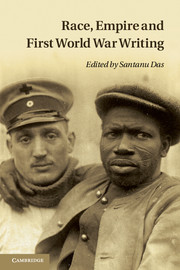Book contents
- Frontmatter
- Contents
- List of illustrations
- Acknowledgements
- Notes on contributors
- Introduction
- PART I VOICES AND EXPERIENCES
- PART II PERCEPTIONS AND PROXIMITIES
- PART III NATIONALISM, MEMORY AND LITERATURE
- 11 ‘He was black, he was a White man, and a dinkum Aussie’: race and empire in revisiting the Anzac legend
- 12 The quiet Western Front: the First World War and New Zealand memory
- 13 ‘Writing out of opinions’: Irish experience and the theatre of the First World War
- 14 ‘Heaven grant you strength to fight the battle for your race’: nationalism, Pan-Africanism and the First World War in Jamaican memory
- 15 Not only war: the First World War and African American literature
- Afterword Death and the afterlife: Britain's colonies and dominions
- Index
- References
11 - ‘He was black, he was a White man, and a dinkum Aussie’: race and empire in revisiting the Anzac legend
Published online by Cambridge University Press: 05 February 2014
- Frontmatter
- Contents
- List of illustrations
- Acknowledgements
- Notes on contributors
- Introduction
- PART I VOICES AND EXPERIENCES
- PART II PERCEPTIONS AND PROXIMITIES
- PART III NATIONALISM, MEMORY AND LITERATURE
- 11 ‘He was black, he was a White man, and a dinkum Aussie’: race and empire in revisiting the Anzac legend
- 12 The quiet Western Front: the First World War and New Zealand memory
- 13 ‘Writing out of opinions’: Irish experience and the theatre of the First World War
- 14 ‘Heaven grant you strength to fight the battle for your race’: nationalism, Pan-Africanism and the First World War in Jamaican memory
- 15 Not only war: the First World War and African American literature
- Afterword Death and the afterlife: Britain's colonies and dominions
- Index
- References
Summary
For over ninety years, Australia has been interpreted, defined, celebrated and criticised through the idea of ‘Anzac’. The word – and particularly its many meanings that have changed over time – can mystify. Dale Blair, an astringent critic of the simple-minded acceptance of Anzac and the author of a frank analysis of its expression through one battalion's experience, took as the epigram to his Dinkum Diggers a complaint by a soldier in the Great War. Frank Gates, a 1st Division machine-gunner, as the Australian War Memorial's condescending catalogue entry put it, was a ‘young man of limited life experience, who rarely engaged in self-reflection’. Even so, he wrote to his mother how
It does not matter where one goes or what paper one reads, there seems to be hardly anything but Anzac and the Anzacs. Anzacs this and Anzacs that until we have become sick of the word.
Many Australian historians may echo this cry of frustration and despair. Can we not evade the complexities and the dominance of the word? Can we not set aside its gravitational pull in drawing attention to the Great War and what it entailed? Sadly, it is neither possible nor desirable to evade the word or its meanings. It is not possible to understand Australia's experience of war in the twentieth century without also understanding the idea of Anzac.
- Type
- Chapter
- Information
- Race, Empire and First World War Writing , pp. 213 - 230Publisher: Cambridge University PressPrint publication year: 2011
References
- 6
- Cited by



